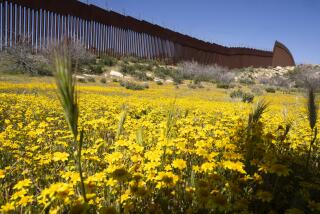‘Eco-Tourism’ Protects Resources in Caribbean : Ecology: From Puerto Rico to Guyana, countries are luring visitors by focusing on cultural heritage and natural or archeological treasures.
- Share via
BOSQUE ESTATAL DE GUANICA, Puerto Rico — When Christopher Columbus landed here nearly 500 years ago, he became the first foreign tourist to visit this coastal forest of bonsai trees, delicate orchids, freshwater springs and rare wildlife.
Now Puerto Rico is developing the Guanica State Forest as an attraction for modern-day “eco-tourists,” who are looking for something other than crowded beaches, noisy casinos and high-rise hotels.
Puerto Rico is not alone. Throughout the Caribbean, governments are developing “eco-tourism” by focusing on their cultural heritage and natural or archeological resources, such as wildlife, coral reefs, caves, rain forests and wetlands.
“All of the Caribbean islands are very fragile ecologically, and large numbers of tourists can destroy this,” said Vera Brereton, a spokeswoman for the Caribbean Tourism Organization. “Eco-tourism is a good way to promote the economic benefits of tourism without damaging the environment”
The Guanica forest, along with Jamaica’s scenic Blue Mountains, Dominica’s lakes and waterfalls, St. Vincent’s rain forest nature trails and Belize’s jaguar reserve and coral reefs rank as some of the choicest eco-tourism destinations in the hemisphere, tourism experts say.
“This forest is exactly as Columbus first saw it. He and his crew came here for water on their second trip to the Caribbean before moving north on the island,” said Miguel Canals, a biologist and head park ranger at the Guanica forest.
The forest of 10,000 acres is about 110 miles southwest of the capital city, San Juan. It boasts more than 120 kinds of birds, such as the nearly extinct Puerto Rican Nightjar, and hundreds of species of plants and trees, including several Guayacon trees that are more than 700 years old.
Wood from Guayacon trees, which grow only in Puerto Rico, was used as money by Dutch and Spanish colonists, who valued the timber for shipbuilding.
Guanica’s turquoise-blue bay was also the site where U.S. soldiers waded ashore in 1898 and seized Puerto Rico from Spanish control.
In 1981 the Guanica forest was designated a U.N. biosphere, or international environmental treasure, to be used by scientists as a standard in rebuilding dry forests throughout the world. A dry forest is one that receives 30 inches of rain or less each year.
“One of my goals is to establish an eco-tourism program,” said Santos Rohena Betancourt, Puerto Rico’s secretary of natural resources. “The main purpose of the program is to develop areas of ecological interest for recreation and education so the people will understand what they have.
“We have to re-examine the policy of the last 20 years concerning the use of natural resources. To continue as we have would be a disaster.”
However, like other eco-tourism destinations, Guanica has had to fend off real estate developers.
Last year, environmentalists succeeded in halting a proposed Club Med resort next to Guanica that would have threatened a turtle nesting area and the habitat of the crested toad, a rare variety that can sleep underground for as long as two years before emerging to eat and mate.
Similar battles have been fought over planned hotel and resort developments in Jamaica, St. Lucia and Grenada.
Elsewhere in the Caribbean, countries are packaging their natural resources to attract environmentally conscious tourists.
That kind of development is well-suited to Caribbean islands, requiring relatively little capital and attracting tourists eager to pay top dollar to see pristine environments and local culture.
Belize, an English-speaking Central American country on the Caribbean, has a thriving eco-tourism industry. It offers tours of Mayan ruins, the world’s second-largest coral reef, tropical rain forests with a rare black orchid and game reserves for the highly endangered jaguar.
Visitors to St. Lucia can hike the Pitons, two unique mountains side-by-side that plug extinct volcanoes. In St. Vincent, nature trails through a rain forest provide glimpses of endangered parrots, as do walks through protected mangrove swamps in Trinidad, where a bird called the scarlet ibis lives.
In Guyana, a former British colony in South America with a Caribbean coast, entrepreneurs invested about $25 million to create Swimtours, which offers thatched huts and caters to bird-watchers, swimmers, spearfishermen and hikers.
St. John in the U.S. Virgin Islands has the Maho Bay Camp, a group of cottages linked by raised wooden walkways to protect the fragile terrain. Visitors can scuba dive in coral reefs or walk through ruins of 18th-Century sugar mills.
More to Read
Sign up for The Wild
We’ll help you find the best places to hike, bike and run, as well as the perfect silent spots for meditation and yoga.
You may occasionally receive promotional content from the Los Angeles Times.






